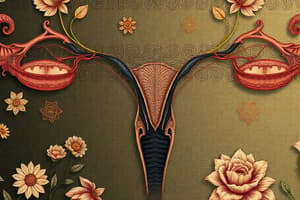Podcast
Questions and Answers
What happens to the follicles during the first 7 days of the menstrual cycle?
What happens to the follicles during the first 7 days of the menstrual cycle?
- They start to grow (correct)
- They stop growing and remain dormant
- They release estrogen into the bloodstream
- They begin to degenerate
What is the primary function of the estrogen secreted by the follicles?
What is the primary function of the estrogen secreted by the follicles?
- To prepare the lining of the uterus for pregnancy (correct)
- To regulate the menstrual cycle
- To induce ovulation
- To stimulate the growth of multiple follicles
What happens to the egg right before ovulation?
What happens to the egg right before ovulation?
- It is fertilized by sperm
- It detaches from the follicle (correct)
- It is released into the abdominal cavity
- It is pushed into the fallopian tube
What causes the follicle to have a growth spurt on Day 14?
What causes the follicle to have a growth spurt on Day 14?
How long does the egg live after ovulation if it is not fertilized?
How long does the egg live after ovulation if it is not fertilized?
What is the function of the cilia in the fallopian tube?
What is the function of the cilia in the fallopian tube?
What is the main reason why the estrogen is secreted into the bloodstream?
What is the main reason why the estrogen is secreted into the bloodstream?
What happens to the majority of the follicles around Day 7?
What happens to the majority of the follicles around Day 7?
Which hormone is released by the pituitary gland in response to estrogen?
Which hormone is released by the pituitary gland in response to estrogen?
What is the role of the fallopian tube in the fertilization process?
What is the role of the fallopian tube in the fertilization process?
What happens to the follicle after it releases the egg into the abdominal cavity?
What happens to the follicle after it releases the egg into the abdominal cavity?
What is the purpose of the chemicals released by the bulging follicle?
What is the purpose of the chemicals released by the bulging follicle?
What happens to the sperm if the egg is not fertilized within 12-24 hours?
What happens to the sperm if the egg is not fertilized within 12-24 hours?
Flashcards are hidden until you start studying
Study Notes
Ovarian Follicle Development
- Ovarian follicles start growing in the first 7 days of the menstrual cycle.
- These follicles secrete estrogen into the bloodstream to prepare the uterus lining for pregnancy.
Follicle Maturation
- By around day 7, all follicles stop growing and degenerate, except for one dominant follicle.
- The dominant follicle continues to grow and nourish the egg inside.
Estrogen and Luteinizing Hormone
- On day 12, the dominant follicle secretes estrogen into the bloodstream.
- When estrogen reaches the hypothalamus and pituitary gland, it triggers the release of luteinizing hormone from the anterior pituitary gland.
Ovulation
- On day 14, the luteinizing hormone causes the dominant follicle to have a growth spurt.
- Right before ovulation, the egg detaches from the follicle.
- The follicle releases chemicals that cause one of the fallopian tubes to move closer and surround the follicle.
- The follicle then swells and bursts open, releasing the egg into the abdominal cavity.
Fertilization
- Cilia move the egg to the entrance of the fallopian tube.
- Contraction in the fallopian tube pushes the egg towards the uterus.
- The egg lives for 12 to 24 hours after ovulation. If not fertilized, it will die.
Ovarian Follicle Development
- Ovarian follicles start growing in the first 7 days of the menstrual cycle.
- These follicles secrete estrogen into the bloodstream to prepare the uterus lining for pregnancy.
Follicle Maturation
- By around day 7, all follicles stop growing and degenerate, except for one dominant follicle.
- The dominant follicle continues to grow and nourish the egg inside.
Estrogen and Luteinizing Hormone
- On day 12, the dominant follicle secretes estrogen into the bloodstream.
- When estrogen reaches the hypothalamus and pituitary gland, it triggers the release of luteinizing hormone from the anterior pituitary gland.
Ovulation
- On day 14, the luteinizing hormone causes the dominant follicle to have a growth spurt.
- Right before ovulation, the egg detaches from the follicle.
- The follicle releases chemicals that cause one of the fallopian tubes to move closer and surround the follicle.
- The follicle then swells and bursts open, releasing the egg into the abdominal cavity.
Fertilization
- Cilia move the egg to the entrance of the fallopian tube.
- Contraction in the fallopian tube pushes the egg towards the uterus.
- The egg lives for 12 to 24 hours after ovulation. If not fertilized, it will die.
Studying That Suits You
Use AI to generate personalized quizzes and flashcards to suit your learning preferences.




